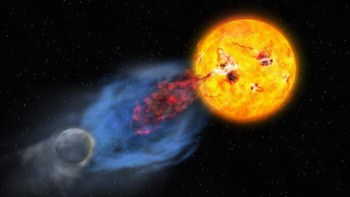Andrew Robinson reviews Gravity’s Century: From Einstein’s Eclipse to Images of Black Holes by Ron Cowen

Science journalist Ron Cowen’s brief but rewarding book – Gravity’s Century: From Einstein’s Eclipse to Images of Black Holes – celebrates two great scientific events concerning gravity that occurred almost exactly a century apart. The first was the November 1919 confirmation of Albert Einstein’s general theory of relativity. This was made possible by British telescopic observations from West Africa and Brazil of a solar eclipse in May 1919, which revealed the deflection of light rays from the Hyades star cluster by the gravity of the Sun. These had been organized by Astronomer Royal Frank Dyson with Arthur Eddington. Analysis of the data proved tricky – hence the delay in announcing the result until a joint meeting of the Royal Society and the Royal Astronomical Society in November of that year. The second event was the 2017 observation, publicised in 2019, by the worldwide Event Horizon Telescope (EHT) of a phenomenon long predicted by general relativity: a black hole. Located 55 million light-years from Earth, in the centre of the Messier 87 galaxy of the Virgo galaxy cluster, the black hole has a mass 6.5 billion times that of the Sun, with an uncertainty of 0.7 billion solar masses. The EHT’s photographs of this esoteric object were published in April 2019 – a month before the publication of Cowen’s book.
Ironically, “Einstein had never liked the idea of black holes; it made his elegant equations blow up and lose their meaning,” writes Cowen. “For decades, he and other physicists could afford to ignore the concept.” Indeed, in 1939 Einstein published a paper – not mentioned by Cowen – in a leading US journal, Annals of Mathematics, which repudiated black holes altogether. In the words of Freeman Dyson, commenting in 2015, the centenary of general relativity: “Einstein constructed a very artificial model of a static black hole, with a cloud of particles of matter orbiting in a hollow spherical shell held together by their mutual gravitational attraction. He showed that this model was impossible because the particles on the outside of the shell would have to travel faster than light.”
When, that same year, J Robert Oppenheimer and his student Hartland Snyder published a paper showing in detail how a massive star, once it had exhausted its nuclear fuel, would naturally collapse into a black hole as a consequence of general relativity, Einstein ignored their joint paper. “How could he have been blind to one of the greatest triumphs of his own theory?” asks Dyson. “I have no answer to this question. It remains one of the inexplicable paradoxes in the life of a genius.”
Almost inevitably, the life and ideas of Einstein provide the thread that binds together Gravity’s Century
Almost inevitably, the life and ideas of Einstein, and his unique scientific legacy, provide the thread that binds together Gravity’s Century. However, the book’s later chapters also describe the discoveries of many currently active physicists – for example, those of Sheperd Doeleman, the lead astronomer of the EHT, who is based at the Haystack Observatory at the Massachusetts Institute of Technology.
There are occasional slips about Einstein’s life, such as a reference to the “science-fiction writer Aaron Bernstein”, whose books strongly influenced the teenaged Einstein towards studying the physics of light in 1890s Germany. Bernstein was in fact a successful popularizer of science, whose 21 small volumes (in German) of People’s Books on Natural Science reported in great detail on current scientific experiments, especially those in Germany. According to Einstein – who wrote a preface to a new edition in 1923 of Bernstein’s The Stars and the Earth – he read Bernstein’s science series “with breathless attention”.
But Einstein’s ideas are well explained by Cowen, as he tracks the still-challenging evolution of relativity from the special theory of 1905 to the much more mathematically sophisticated general theory of a decade later. Thus he writes: “In Newtonian gravity, space and time are the featureless backdrops, the silent and immutable stage upon which the universe’s actors – humans, bowling balls, planets, and stars – strut their stuff. Even in Einstein’s special theory of relativity, which wove space and time into a single fabric, the ticks of a clock and the markings of a ruler are spectators, exerting no influence on the comings and goings of the cosmic players. Einstein’s general theory, however, demands that the stage is an equal partner in the action, a malleable and dynamic participant.”
The book’s description of the EHT is particularly awe-inspiring. In effect, says Cowen, the EHT “freezes the light” from its constituent observatories by creating electronic copies of all the radio waves that fall in Chile, Mexico, Spain, Greenland, the South Pole, Hawaii and Arizona. The arrival time of every radio signal at each of these telescopes/telescopic arrays is recorded with high precision, using atomic clocks that lose only a second every 10 million years. “That’s the only way supercomputers can determine the difference in arrival time between radio signals recorded in each array, and identify which pairs of signals should be combined to create an interference pattern.”
From the intensity and spacing of the interference fringes, the shape and size of the distant stars and objects emitting the signals can then be reconstructed. No wonder that two years of demanding computer analysis were required after the EHT received the data from the M87 galaxy before astrophysicists could confidently publish their celebrated black hole photograph. If only Einstein were still around to give us his personal reaction.
- 2019 Harvard University Press 176pp £19.95hb
- To read more of Andrew Robinson’s writing about Einstein, see “Einstein in Oxford”



